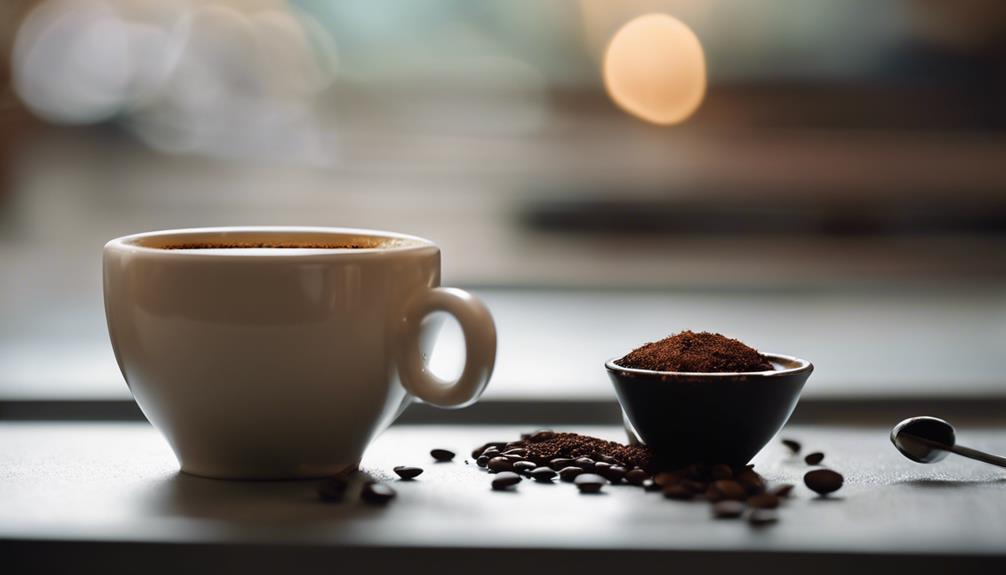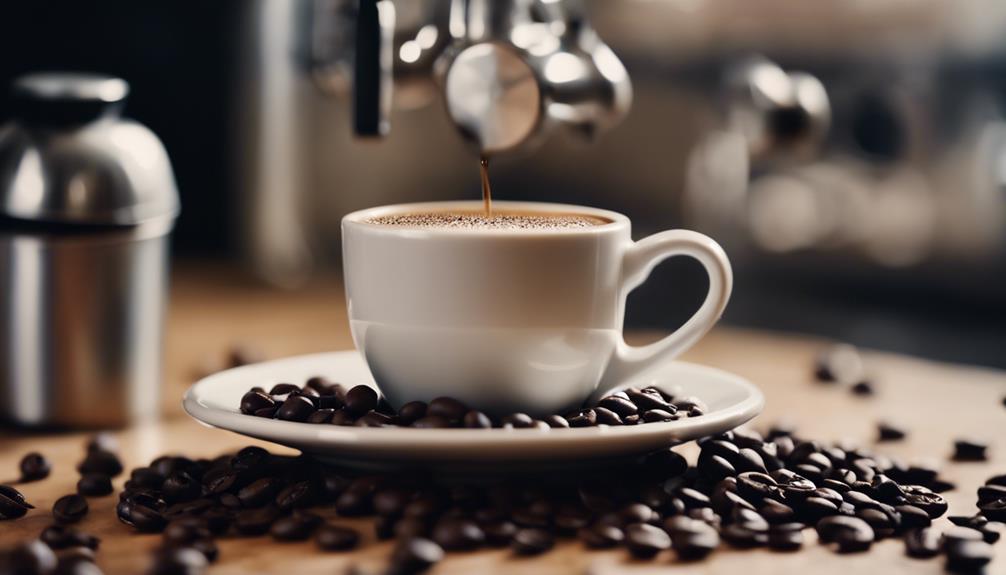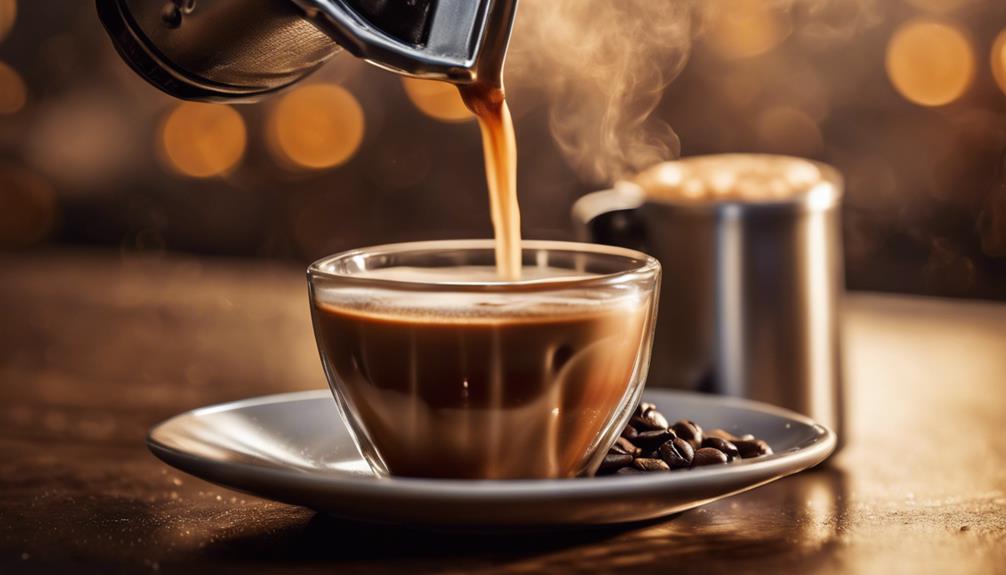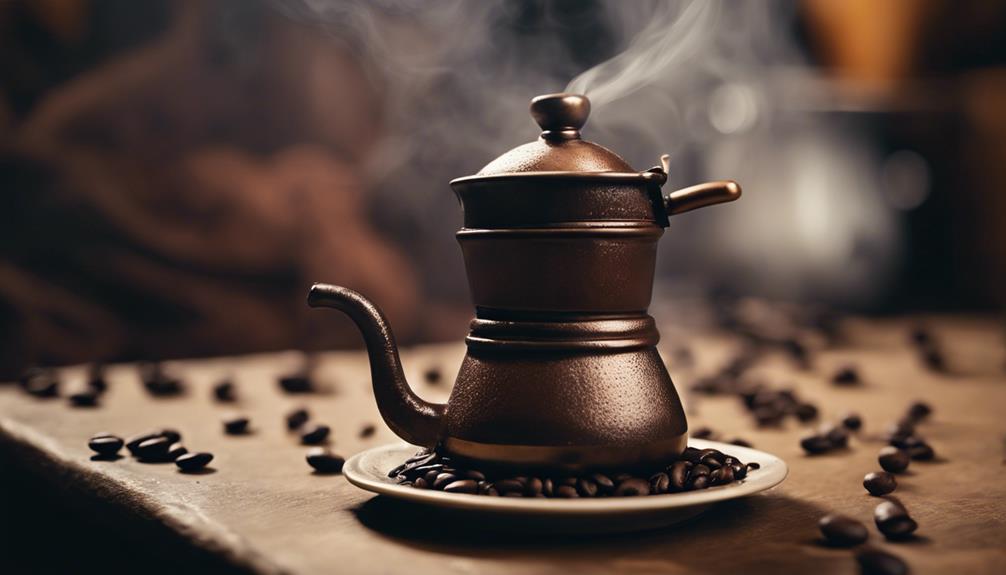You might be curious about the caffeine content in a single shot of espresso. Surprisingly, a 1-ounce shot contains around 63 milligrams of caffeine. However, it’s important to note that the type of coffee bean used can influence the caffeine levels, with Robusta beans having more caffeine than Arabica beans. If you opt for a double shot, you can expect approximately 126 milligrams of caffeine. But what about the brewing process and its impact on caffeine content? Understanding these details will help you make informed decisions about your daily espresso consumption.
Key Takeaways
- A single 1-ounce shot of espresso contains approximately 63 mg of caffeine.
- Caffeine levels in espresso vary based on the type of coffee bean, with Robusta beans containing more caffeine than Arabica beans.
- Espresso-based drinks, such as cappuccinos or lattes, have similar caffeine content to a single shot of espresso.
- A double shot (doppio) of espresso contains around 126 mg of caffeine, doubling the amount of a single shot.
Caffeine Content in Espresso
When you order a shot of espresso, you're getting a concentrated dose of caffeine that's more potent than brewed coffee, with a single 1-ounce serving packing approximately 63 mg of caffeine. This amount can vary, but the type of coffee beans used is a key factor. Espresso shots made with Robusta beans, for instance, generally contain higher caffeine levels compared to Arabica beans.
As you take that first sip of espresso, the caffeine content can make you wonder why some shots are more potent than others. One reason lies in the brewing methods, since these greatly affect caffeine extraction. For espresso, finely ground beans and the intense water pressure force caffeine into your cup faster, amplifying its concentration.
Moreover, with every 1-ounce shot containing a generous 63 mg of caffeine, and the compact, thick crema potentially harboring an even richer hit of this stimulating agent, an espresso drink can overpower regular cups of brewed coffee without consuming too many fluids.
Although ground texture impacts final coffee and drink result in a direct manner via filtering effects due to extract compound solvent mechanics, it can also lead to quicker extraction when utilizing a filter. This interplay of factors ultimately affects the final caffeine content and overall experience of the drink.
Brewing Techniques and Preparation
To brew the perfect shot of espresso, you'll need to master the right techniques and preparation methods, starting with the grind size and coffee-to-water ratio. The ideal grind size is similar to table salt, and you'll want to use 6-8 grams of coffee for a single shot and 15 grams for a double shot.
| Brewing Method | Best Water Temperature | Brew Time |
|---|---|---|
| Traditional Machine | 190°F – 205°F | 25-30 seconds |
| Stovetop Moka Pot | 190°F – 205°F | 4-6 minutes |
| Portable Espresso Maker | 190°F – 205°F | 1-2 minutes |
When using an espresso machine, pre-run hot water through it to clear any residual coffee oils and enhance the flavor of your shot. The best water temperature for extracting espresso is between 190°F to 205°F. Pay attention to the crema, a golden foam on top of the espresso, which indicates a well-pulled shot and quality extraction. By mastering these brewing techniques and preparation methods, you'll be well on your way to crafting the perfect shot of espresso. Remember to experiment with different coffee grounds and ratios to find your ideal flavor profile.
Health Benefits and Myths
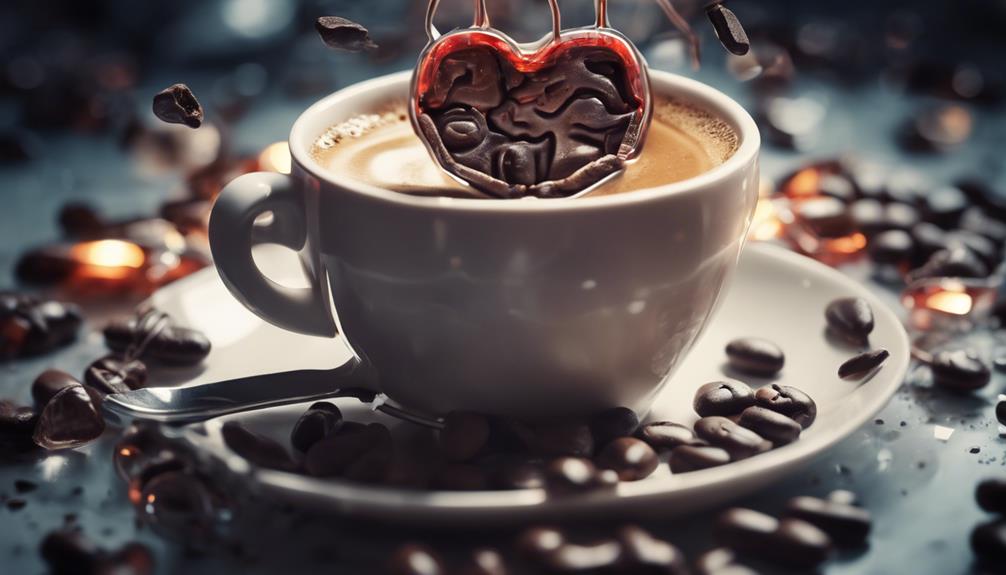
Espresso, often misunderstood as a guilty pleasure, actually packs a punch of health benefits that can enhance your overall well-being. As a coffee drinker, you're likely aware of the caffeine in espresso, but you might be surprised to learn about the other advantages it offers.
Here are three key health benefits of moderate espresso consumption:
- Boosts cognitive function: Caffeine in espresso can improve alertness and performance, with studies showing up to an 11% improvement in tasks that require attention and memory.
- Rich in antioxidants: Espresso contains a wealth of antioxidants, which can help lower the risk of diabetes and boost your immune system.
- May reduce disease risk: Moderate coffee consumption, including espresso, has been linked to a lower risk of strokes and heart disease.
As a regular coffee drinker, you may experience built-up tolerance to caffeine, allowing you to enjoy espresso without adverse effects.
Cultural Impact of Coffee
As you explore the cultural impact of coffee, you'll notice how it brings people together, creating social hubs that foster connections and community.
You'll also see how coffee's popularity has driven economic growth in producing regions, influencing global trade dynamics.
Social Hub Creation
You step into a bustling coffee shop and immediately sense the vibrant atmosphere, where strangers become friends over a shared love of coffee. The space transforms into a dynamic social hub that fosters community bonding and cultural exchange. As you wait in line, you notice the diverse crowd, all united by their passion for coffee. This shared interest breaks down social barriers, allowing people to connect and form meaningful relationships.
Coffee shops have become an integral part of our social routines, providing a welcoming space for community bonding and cultural exchange. Here are just a few ways they achieve this:
- Hosting coffee events: From coffee cupping sessions to live music performances, coffee shops offer a variety of events that encourage social interaction and community engagement.
- Showcasing local art: Many coffee shops feature local art exhibitions, promoting cultural expression and supporting local talent.
- Offering coffee workshops: By providing educational workshops, coffee shops help customers appreciate the rich coffee culture and traditions behind their favorite brews.
As you enjoy your coffee, you're not just satisfying your caffeine craving – you're participating in a vibrant coffee culture that brings people together.
Economic Growth Factors
The cultural impact of coffee has become a notable driver of economic growth, with its influence extending far beyond the coffee shop to stimulate development in regions where it's cultivated and traded.
As you consider the role of coffee in the economy, you'll see that it's an essential source of income for millions of farmers in developing countries. In fact, the global coffee industry contributes considerably to economic growth, with coffee production being a key player. Coffee shops also play an important role in local economies, creating jobs and attracting tourists.
You'll notice that coffee cultivation and trade have a profound impact on regions like Latin America and Africa. The industry stimulates investment in infrastructure and education, leading to economic development.
As the global coffee market continues to grow, it's clear that coffee is more than just a commodity – it's a driving force for economic growth. With a global market value of approximately $102.15 billion in 2020, coffee's influence is undeniable.
Global Coffee Trends
Coffee's far-reaching influence on modern culture is evident in the diverse trends that have emerged globally, reflecting its profound impact on our daily lives and social interactions.
As you explore the world of coffee, you'll notice that global coffee trends are shaped by local coffee cultures, caffeine levels, and brewing methods. Here are three key trends that highlight the importance of coffee in modern society:
- Community hubs: Coffee shops have become essential gathering spaces, fostering social connections and contributing to local economies worldwide.
- Cultural expressions: Coffee has inspired various lifestyle movements, artistic expressions, and literature, reflecting its deep cultural significance in societies across the globe.
- Sustainable practices: Coffee production has spurred economic growth in coffee-producing regions, impacting livelihoods and encouraging sustainable agricultural practices.
As you navigate the world of coffee, you'll discover that global coffee trends aren't just about caffeine levels or brewing methods, but about the cultural significance of coffee in our daily lives.
Whether you're a coffee connoisseur or just a casual fan, understanding these trends can enrich your appreciation for this beloved beverage.
Enjoying Espresso Responsibly

As you explore the world of espresso, it's crucial to reflect on how to enjoy it responsibly.
You'll want to understand the guidelines for caffeine intake and how they relate to espresso serving sizes, which can vary markedly from other types of coffee.
Caffeine Intake Guidelines
When it comes to enjoying espresso responsibly, you'll want to keep your caffeine intake in check, especially since a single shot packs a concentrated punch of approximately 63 mg of caffeine per ounce.
To put this into perspective, health experts recommend that healthy adults limit their daily caffeine intake to a maximum of 400 mg, which is equivalent to around six shots of espresso.
To guarantee you're enjoying espresso in moderation, consider the following guidelines:
- Daily limit: Don't exceed 400 mg of caffeine per day, which is roughly six shots of espresso.
- Timing is everything: Avoid consuming espresso after 3 PM to prevent disrupting your sleep patterns.
- Be mindful of your sensitivity: Pay attention to how your body reacts to caffeine, and adjust your intake accordingly.
Espresso Serving Sizes
You'll typically find that a standard serving size of espresso is 1 ounce, which packs a concentrated punch of caffeine that's considerably higher than brewed coffee. This small serving size is what makes espresso so potent, with a single shot containing about 63 mg of caffeine.
When you order a double shot, or doppio, you're getting around 126 mg of caffeine. The type of espresso beans used can also impact the caffeine content, with Robusta beans containing more caffeine than Arabica.
When considering espresso serving sizes, it's important to remember that the caffeine content can vary slightly depending on the coffee bean type. However, a standard shot of espresso will generally contain around 63 mg of caffeine.
If you're ordering an espresso-based drink, such as a cappuccino or latte, the caffeine content will be similar to a single shot, around 75 mg, due to the added milk.
Understanding espresso serving sizes and the caffeine content in a shot can help you enjoy your espresso responsibly and make informed choices about your caffeine intake.
Responsible Consumption Tips
How can you enjoy espresso responsibly and make the most of its energizing effects while minimizing potential drawbacks? To do so, it's crucial to understand the amount of caffeine in a shot of espresso and how it can impact your body.
Here are three tips to help you enjoy espresso responsibly:
- Limit your intake: Stick to a moderate level of caffeine consumption, up to 300 mg daily, to avoid adverse effects. Be mindful of the amount of espresso in your drinks, as a double shot can contain more caffeine than a typical 8 oz cup of brewed coffee.
- Time it right: Enjoy espresso in the morning or pre-3 PM to avoid interfering with your sleep patterns. Caffeine can affect alertness and restfulness later in the day.
- Join the conversation: Engage with coffee communities to enhance your understanding of espresso and promote responsible consumption habits. Share experiences and tips on enjoying different coffee types to get the most out of your espresso.
Caffeine Levels in Coffee Types
You might notice notable differences in caffeine levels between various types of coffee, especially when comparing a single shot of espresso to a typical cup of brewed coffee.
For instance, a single shot of espresso packs about 63 mg of caffeine per 1 ounce, whereas an 8-ounce cup of brewed coffee contains approximately 96 mg. This makes espresso more concentrated regarding caffeine. Additionally, you'll find that shots of espresso, especially a double shot (doppio), can deliver around 126 mg of caffeine – roughly one-third more than what's in an 8-ounce cup of coffee.
When it comes to coffee beans, the type plays an important role in determining caffeine levels. You'll find that Robusta beans contain considerably more caffeine than Arabica beans.
So, if you're looking for a caffeine kick, Robusta might be the way to go. However, if you prefer a smoother taste, Arabica beans are a better option.
As you explore different coffee types, keep in mind that the caffeine content can vary considerably, making it essential to be aware of what you're consuming. By understanding these differences, you can make informed choices about your coffee habits.
Coffee Roasting Effects on Caffeine
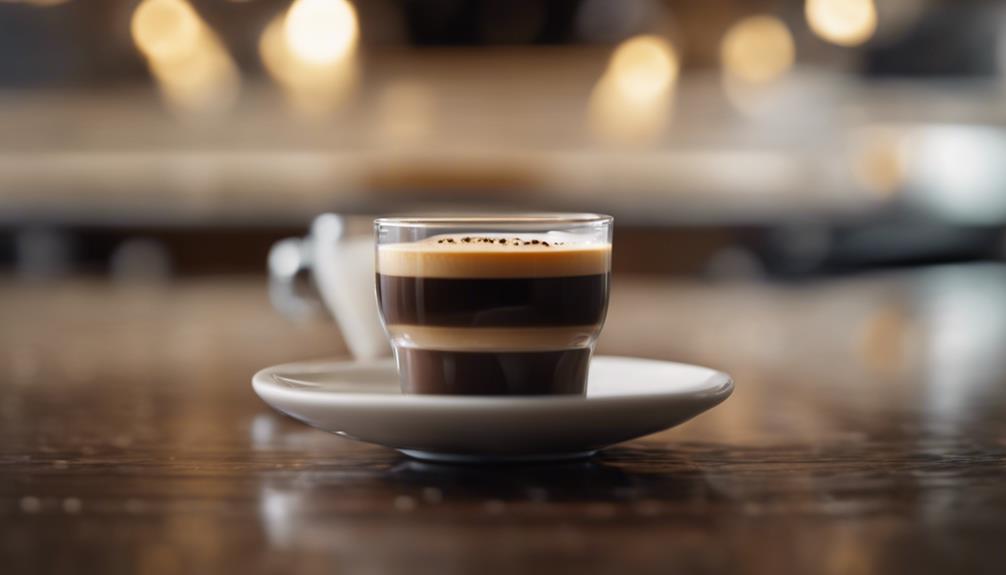
You're likely aware that roast level impacts the flavor profile of your espresso, but did you know it also affects the caffeine concentration?
As you explore the effects of roasting on caffeine, you'll discover that the relationship between roast level and caffeine isn't as straightforward as you might think.
In fact, you'll find that darker roasts can actually have higher caffeine concentrations than lighter roasts, contrary to popular belief.
Caffeine Concentration Varies
What's surprising is that the caffeine concentration in espresso can vary greatly depending on the roast level of the coffee beans. You might assume that the caffeine content is consistent across different roasts, but that's not the case. The roasting process itself affects caffeine levels, and the type of roast can considerably impact the caffeine concentration in your espresso.
Here are three key facts about caffeine concentration and roast level:
- Dark roast has the highest caffeine content: Despite the common belief that dark roasts contain less caffeine, the increased porosity from the roasting process aids in easier caffeine extraction, resulting in higher caffeine levels.
- Lighter roasts yield more coffee by weight: Lighter roasts have retained more of their original caffeine, but the density reduction during roasting can lead to differences in caffeine content in brewed beverages.
- Brewing method and roast type influence caffeine extraction: The method of brewing and the roast type also influence caffeine extraction dynamics, with different brewing times impacting the amount of caffeine that can be extracted from the espresso grounds.
When brewing coffee, the roast level and brewing method can considerably impact the caffeine concentration in your espresso.
Roast Level Impacts
Considering the effects of coffee roasting on caffeine, it's essential to examine how different roast levels impact the final caffeine concentration in your espresso. You might be surprised to learn that the roast level of your coffee beans plays a significant role in determining the amount of caffeine in your espresso.
| Roast Level | Caffeine Concentration (mg/deciliter) |
|---|---|
| Light Roast | 62 |
| Medium Roast | 67.5 |
| Dark Roast | 72 |
| Espresso Roast | 80-100 |
| Italian Roast | 90-110 |
When you use a dark roast to make your espresso, you're likely to get a higher caffeine concentration compared to using a light or medium roast. This is because the increased porosity of darker roasts aids in easier caffeine extraction during brewing. Additionally, the amount of coffee grounds used to make your espresso also affects the caffeine content. Typically, 18 grams of coffee grounds are used to make a shot of espresso, which yields around 110 mg of caffeine. However, this can vary depending on the roast level and brewing method used. By choosing a dark roast, you can expect a higher caffeine kick in your espresso.
Caffeine Extraction Dynamics
Within the brief 25-30 seconds it takes to pull an espresso shot, a complex dynamic of caffeine extraction unfolds. As you watch the espresso machine work its magic, you might wonder what's happening behind the scenes. The answer lies in the unique brewing process of espresso, which affects the caffeine extraction from the coffee beans.
Here are three key factors that influence caffeine extraction in espresso:
- Contact time: The short brewing time of espresso means that caffeine extraction is limited, resulting in a lower overall caffeine yield compared to methods like filter coffee.
- Grind size: The fine grind used for espresso allows for greater surface area contact with water, enhancing caffeine transfer and extraction.
- Coffee bean density: The density of the coffee beans also plays a role, with denser beans generally producing more concentrated espresso shots.
As you enjoy your espresso, remember that the caffeine extraction process is a delicate balance of time, grind, and bean density. Understanding these dynamics can help you appreciate the art of espresso-making and the unique characteristics of your favorite shot.
Espresso Vs Coffee Comparison

Typically, when comparing espresso to coffee, you'll find that the caffeine content varies considerably between the two, despite their shared origins from coffee beans. To better understand this difference, let's take a look at the numbers.
| Type of Coffee | Serving Size | Milligrams of Caffeine per Serving |
|---|---|---|
| Espresso | 1 ounce | 63 mg |
| Brewed Coffee | 8 ounces | 96 mg |
| Double Shot Espresso | 2 ounces | 126 mg |
As you can see, espresso has a higher concentration of caffeine per ounce compared to brewed coffee. However, when considering the typical serving sizes, brewed coffee often contains more caffeine overall. The type of coffee beans used also plays a role in the caffeine content, with Robusta beans generally yielding more caffeine than Arabica beans. Additionally, the brewing method impacts caffeine extraction, with espresso's rapid transfer resulting in a more concentrated beverage. When you order an espresso-based drink, keep in mind that the caffeine content can add up quickly, especially if you're having multiple shots.
Managing Caffeine Intake
Now that you've seen how the caffeine content in espresso compares to brewed coffee, it's time to think about how you can manage your caffeine intake to enjoy your favorite espresso-based drinks responsibly.
As a coffee drinker, it's important to be mindful of your caffeine consumption to avoid exceeding the recommended daily limit of 300 mg.
Here are three tips to help you manage your caffeine intake:
- Track your espresso shots: Keep an eye on the number of espresso shots you consume in a day, especially if you're a fan of cappuccinos and lattes. Multiple shots can add up quickly, so be mindful of the cumulative effect.
- Consider your brewing method: Different brewing methods yield varying caffeine contents. If you're switching between espresso and brewed coffee, be aware of the differences in caffeine concentration.
- Be aware of your tolerance: If you're a regular coffee drinker, you may have built up a tolerance to caffeine. However, it's still important to stay within recommended guidelines to avoid potential health risks.
Frequently Asked Questions
Is 2 Shots of Espresso a Lot of Caffeine?
You're wondering if 2 shots of espresso is a lot of caffeine? It's relatively moderate, considering a double shot contains about 126 mg, which is within the safe daily limit of 300 mg for healthy adults.
How Much Caffeine Is in a Single Shot of Espresso?
You gaze at the rich, velvety espresso, its crema inviting. When you wonder how much caffeine is in a single shot, know that you're about to ingest roughly 63 mg, a concentrated dose that's sure to kickstart your day.
How Much Caffeine Is in 1 Shot of Starbucks Espresso?
You're wondering how much caffeine is in 1 shot of Starbucks espresso? It's about 75 mg, which is higher than the average espresso shot. This amount can provide a quick energy boost, so be mindful of your intake.
Which Has More Caffeine, Espresso or Regular Coffee?
You might think a shot of espresso packs a bigger caffeine punch, but surprisingly, a standard 8-ounce cup of brewed coffee typically contains more caffeine. Imagine a concentrated espresso "spark" versus a brewed coffee "wave".
What is the actual amount of caffeine in a shot of espresso?
The caffeine content in espresso shot can vary depending on the specific type and brewing method. On average, a single shot of espresso contains around 63 milligrams of caffeine. However, the exact amount can be influenced by factors such as bean variety, roast level, and water temperature.
Conclusion
As you savor your espresso, remember it's like steering through a stormy sea – the caffeine can toss you about if you're not careful.
In the right balance, however, it's a sweet spot. Enjoy the rush of alertness, the lift in your day.
We've weighed anchor, explored the myths and mysteries, and measured the dose of that essential bean-based ingredient: caffeine.
Steer the shot that perks you up without getting tossed about – sip with purpose, drink responsibly, and cherish that treasured balance!
